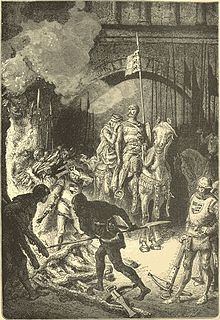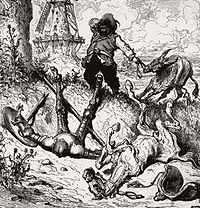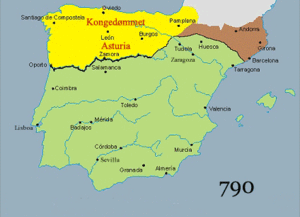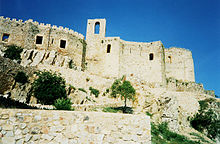- Spanish chivalry
-
During the Middle Ages, Medieval Europe was engaged in almost constant warfare and conflict.[1] European warfare during the Middle Ages was marked by a transformation in the character of warfare from antiquity, changing military tactics and the role of cavalry and artillery.[2] In addition to military tactical and technological innovations during this period, chivalric military and religious ideals arose giving motivation for engagement in the ceaseless warfare. In the Iberian Peninsula (particularly in Spain or the territories that would come to be Spain), chivalric ideals and institutions would be adopted and exercised with more fervor than anywhere else.[3]
Contents
History
Chivalric precursors
Chivalric ideals can be traced back to Islam from the 7th century CE and in which it is best characterized as a code of formalities and traditions, and, unlike later Christian Chivalry, not a religious or political system. Organized Islamic chivalry, with principles and social customs, originated in Andalusia under the Caliphate of Cordova, and derived its conventions from the principles of honor, courtesy, and virtuous character.[4] Around the 10th century CE Futuwwas,"heroic generosity", were guilds or urban organizations of Sufi Muslims, which promoted ideals of nobility, which thought that through hospitality and generosity one would always put others above oneself.[5] "According to Sufis, futuwwah is a state of mind that is animated by selflessness, compassion, kindness, and altruism. This behavior was modeled by the Prophet Muhammad and by other friends and lovers of Allah. The word that describes the Sufi brand of chivalry is adab. They see it as "a continuous act of devotion, for it is a method of constant remembrance of God."' [6] These percursory chivalric elements and ideals are thought to have been acculturarted into Spanish Christianty in "Al-Andalusian" Spain, since the Christian and Islamic cultures were so enmeshed for nearly 800 years.
However,the institutionalization of Christian Chivalry originated in France and is thought to have been inspired by the Hundred Years War. Chivalry essentially encapsulates the Christian fighter spirit of the Knightly system of the Middles Ages with religious, moral, social codes used to guide the conduct of Christian military engagement.[7] Having developed out of the feudal system of France, chivalry was essentially rules of conduct and manners shaped by early fraternal knightly orders to direct member-knights to act in accordance with church doctrine on topics of violence and war.[8]
From 975 CE – 1025 CE the Church’s stance was for the promotion of peace in conflict, and is encapsulated in the expression ‘Peace of God’ – pactum paci (peace treaty). However, the succeeding two hundred years yielded complex and shifting opinions among Christians in the discussion of war.[9] In 1038, Aimon – Archbishop of Bourges, made what is thought to be the first initiative to oblige male Christian faithful over the age of 15 to take to arms in defense of the faith.[9] Contemporary and succeeding edicts and councils held that violence in the defense of the faith was permissible, except for on holy days, or limited the use of bowmen and archers in warfare.[10][11] “The peace movement favoured definition and promotion of the chivalric ideal.” [12] The first noted support for chivalric vocation, or the establishment of knightly class to ensure the sanctity and legitimacy of Christianity was written in 930 by Odo, abbot of Cluny in the Vita of St. Gerald of Aurillac, which argued that the sanctity of Christ and Christian doctrine can be demonstrated through the legitimate unsheathing of the “sword against the enemy.” [13] A shift occurred during the 9th century CE – 11th century CE where the Church moved the obligation of protecting and defending the poor and faithful on pilgrimage to holy sites form Kings to the milites, or early Knights, who established and perpetuated a chivalric ideal and code of manners in early Orders.[14] With the Council of Clermont by Pope Urban II, holy war in the defense of the Christian faith was permissible and those warriors who engaged in holy war, had the possibly of redemption through plenary indulgence and in addition believed that if they properly engaged in correct military engagement, tempered by chivalric ritual, would more likely be in good spiritual standing upon death.
Spanish chivalry
Early Spanish chivalry
Chivalry, or chivalric codes of manners and proper military engagement, is believed to have arrived in the Iberian Peninsula during the 10th century CE, in the context of the Reconquista, when Frankish knights, who were willing to fight the ‘infidel’ prior to the Crusades, appeared to protect pilgrims flocking to the tomb of apostle James of Campstella in Galicia.[15] St. James himself was known and celebrated in Christianity as ‘the slayer of the Moors’ and the discovery of his body by Christians has been considered a possible igniting factor of the Reconquista.[16] The Reconquista had began under Alfonso II (791–842), and would last nearly 700 years as Christians attempted to suppress and push Muslims from the Iberian Peninsula. However, the instatement of chivalric knightly orders and the chivalric ideals and codes of conduct weren’t present on the Iberian Peninsula until almost the second century of the Reconquista. In the context of the Reconquista, and the geographically close proximity of Christian and Muslim populations, the atmosphere for the development of Knightly Orders was ripe and in the subsequent centuries chivalry flourished in Spain to a greater extent than it did in other Christian states.[3]
Chivalry in Medieval Spain cannot be understood outside of the context of the Military Orders of Knighthood. Historians seem to be conflicted as to whether Knights in Spanish were directed more by Castilian and Catalan-Aragonese royalty or by the Papacy. But there seems to be a consensus that the knights had obligations to both and an overarching allegiance to the Church, as both were in direct contact with knights (and often royalty were themselves knights and Crusaders).[14] Some scholars have suggested that the loyalty of the later Spanish Military Orders like that at the fortress of Calatrava, pledged there loyalty primarily to their Kingdom, in this case Castile, but orders like the Templars or Hospitallers were more independent and not necessarily loyal to any kingdom consistently.[17]
The uniqueness of Spanish chivalry
The Iberian Peninsula had multiple factors contributing to the strong chivalric ethos exemplified by Spanish Knights. One determinate factor to the strong adoption of chivalric Orders, in Spain, is the Reconquista in which Christian Kingdoms attempted to expel Muslims from the peninsula. The greatest foe of the Spanish Christian knight was above all Muslims, who were not an imagined enemy, but one deeply entrenched in reality and not as distant as the infidel, or enemy, was for the knights of France or Germany. In other Christian kingdoms the fighting was at least initially waged between Christians of different kingdoms, and as such was more debated and contested within Christian circles.[18] However, in Spain the Christian knights and kingdoms were engaged with what was almost universally acknowledged as a foe to Christianity, and this common enemy had some role in uniting Christian kingdoms in the cause of the Crusades and Reconquista.[19] In the 12th–13th century, most of the prominent Spanish Knightly orders were formed. The early formation of the Orders of the peninsula was dangerous and unstable. In Calatrava, during the middle of the 12th century Castilian Knights established a fortress, which would later be abandoned due to the threat of Muslim threat, then again within fifty years a fort of the Order of Calatrava was then rebuilt and became a fortified monastic community.[20]
The prominence of knightly orders in the political and military realms of the Christian kingdoms of the peninsula fluctuated with the crusader zeal of the kingdoms’ rulers; however, their power was not exclusively tied to the Crusader Kings. For instance, Ferdinand III of Castile’s reign facilitated the rise of more Spanish Orders because of the desire in the kingdom led by the king to crusade against the moors.[21]
However the years that followed the death of Ferdinand III were relatively peaceful in Castile and the morale of the Orders were undermined. In this period of peace between the Orders and the Muslims of the peninsula: mercenaries were hired to replace and assist Knights in their fighting, Masters of the Orders were no longer religiously appointed, and civil war was waged between Christian Knights with conflicting loyalties.
The decline of knightly Orders in Spain is the subject of much debate. Some historians have attributed the fall of Chivalry and Knightly Orders to Cervantes because he “smiled Spain’s chivalry away” with his satirical Don Quixote.[3] Others have suggested that Chivalry's decline was due to the expulsion of the Muslims with the fall of Granada in 1492, or the centralization of political power under the reign of Ferdinand and Isabella.[22] “Once the mission of driving the Moors from Spain was accomplished, the four Orders, like the great crusader Orders elsewhere in Europe, were perceived as over-mighty subjects and it became a priority for the Crown to gain control over them – particularly as the not infrequent quarrels between the rival bodies was a source of dissension at a time when the Crown was struggling to establish its central authority.
The Spanish kings had frequently obtained the election of close connections of their families as Masters of the Orders and at Calatrava in 1489, Santiago in 1494 and Alcántara in 1495 the administration of the three Magisteries were ultimately granted to King Ferdinand of Aragón, as Sovereign of Aragón and King-Consort of Castille. Finally, by the Bull Dum intra of Pope Adrian VI dated 4 May 1523, the `perpetual administration' of the three Orders was transferred to "Charles I (the Holy Roman Emperor Charles V), King of Spain, and his heirs and successors…” [23]
Later incarnations of Spanish chivalry
After the Reconquista and the loss of their prominence in the peninsula, Spanish Orders then found a new role as an elite corps of the nobility, maintaining their castles and estates as commanderies to provide incomes for those who had distinguished themselves in the service of the Monarch. The succeeding centuries however saw the rise of the Spanish Empire and the chivalric ideals of the knights transcended and reappeared in the guise of the conquistadors in the New World. “The rewards for the conquistador were similar to those of his medieval predecessor, the reconquistador: land to conquer, people to convert to Christianity, and glory or fame. The one major difference was that the conquistadors and reconquistadores were real people who also sought wealth whereas the knight-errant of the romances was a fictional creature indifferent to material gain. Bernal Díaz de Castillo, a soldier who took part in the conquest of Mexico, put the conquistador’s objective succinctly: “we came here to serve God and the king and also to get rich” .[24][25]
Spanish chivalric literature
El Cid
 Engraving by Alphonse-Marie-Adolphe de Neuville of the Cid ordering the execution of the instigator of the revolt and almoravid after his conquest of the city in 1094.
Engraving by Alphonse-Marie-Adolphe de Neuville of the Cid ordering the execution of the instigator of the revolt and almoravid after his conquest of the city in 1094.
El Cantar de Myo Çid ( El Poema de Myo Çid or Mio Cid, literally The Song of my Lord), also known in English as The Lay of the Cid and The Poem of the Cid is the oldest preserved Spanish epic poem. Based on a true story, it tells of the Spanish hero El Cid, and takes place during the Reconquista, or reconquest of Spain from the Moors. “The protagonist of the poem is the historical Rodrigo Díaz de Vivar (c. 1045–1099), also known as Cid (a dialectal form of the Arabic word sayyid, 'lord' or 'master') and Campeador ('Battler' or 'Victor'). The poem begins with the departure of Rodrigo from his home in Vivar, the first of two exiles of Rodrigo decreed by Alfonso VI, king of Castile and Leon (1065–1109). In the poem this first exile (1081) and the second (1089) are conflated and lead to the Cid's military campaigns in the Spanish Levant, culminating in the Cid's conquest of the Moorish kingdom of Valencia (1094). Here Rodrigo will remain with his wife and children as an independent prince until the end of his life.” [26]
Don Quixote
 Don Quixote, his horse Rocinante and his squire Sancho Panza after an unsuccessful attack on a windmill. By Gustave Doré
Don Quixote, his horse Rocinante and his squire Sancho Panza after an unsuccessful attack on a windmill. By Gustave Doré
is a novel written by Spanish author Miguel de Cervantes. Published in two volumes a decade apart (in 1605 and 1615), Don Quixote is the most influential work of literature from the Spanish Golden Age in the Spanish literary canon.
“A Spanish knight, about fifty years of age, who lived in great poverty in a village of La Mancha, gave himself up so entirely to reading the romances of chivalry, of which he had a large collection, that in the end they turned his brain, and nothing would satisfy him but that he must ride abroad on his old horse, armed with spear and helmet, a knight-errant, to encounter all adventures, and to redress the innumerable wrongs of the world. He induced a neighbour of his, a poor and ignorant peasant called Sancho Panza, mounted on a very good ass, to accompany him as squire. The knight saw the world only in the mirror of his beloved romances; he mistook inns for enchanted castles, windmills for giants, and country wenches for exiled princesses. His high spirit and his courage never failed him, but his illusions led him into endless trouble. In the name of justice and chivalry he intruded himself on all whom he met, and assaulted all whom he took to be making an oppressive or discourteous use of power. He and his poor squire were beaten, trounced, cheated, and ridiculed on all hands, until in the end, by the kindliness of his old friends in the village, and with the help of some new friends who had been touched by the amiable and generous character of his illusions, the knight was cured of his whimsies and was led back to his home in the village, there to die.” [27]
Prominent Knightly Orders of Spain
Order of Calatrava – was the first military order founded in Castile, but the second to receive papal approval. The papal bull confirming the Order of Calatrava as a Militia was given by Pope Alexander III on September 26, 1164.[25]
Order of Santiago – or the Order of Saint James of Compostela was founded in the 12th century, and owes its name to the national patron of Spain, Santiago (St. James the Greater), under whose banner the Christians of Galicia and Asturias began in the 9th century to combat and drive back the Muslims of the Iberian Peninsula.[28]
Order of Alcántara – also called the Knights of St. Julian, was originally a military order of León, founded in 1166 and confirmed by Pope Alexander III in 1177.[29]
Order of Montesa – was dedicated to Our Lady, and based at Montesa. Pope John XXII approved it on 10 June 1317, and gave it the Cistercian rule.[30]
See also
References
- ^ Medieval Warfare. Hyw.com. Retrieved on 2011-06-04.
- ^ MedievalWarfare.org, Medieval Warfare in Europe
- ^ a b c Prestage, p. 109
- ^ History of Chivalry in Christianity and Islam – Masabih Islamic Forum. Masabih.org (2005-01-25). Retrieved on 2011-06-04.
- ^ ibn al-Husayn al-Sulami,Muhammad. The Way of Sufi Chivalry
- ^ Spirituality & Practice: Book Review: The Way of Sufi Chivalry, by Muhammad ibn al-Husayn al-Sulami. Spiritualityandpractice.com. Retrieved on 2011-06-04.
- ^ Prestage, pp. 1–2
- ^ Prestage, pp. 2–7
- ^ a b Contamine, p. 271
- ^ Contamine, pp. 272–3
- ^ Second Lateran Council – 1139 A.D. – http://www.piar.hu/councils/ecum10.htm
- ^ Contamine, p. 275
- ^ Thomas F. X. Noble, Thomas F. Head Soldiers of Christ: saints and saints lives from late antiquity and the early Middle ages “The Life of St. Gerald, by Odo”. Penn State Press, 1954, p 371.
- ^ a b Contamine, p. 277
- ^ Contamine, pp. 55–6
- ^ Barber, p. 145
- ^ Cite error: Invalid
<ref>tag; no text was provided for refs namedBarber.2C_p._145; see Help:Cite errors/Cite error references no text - ^ Prestage, pp. 81, 109
- ^ Ludlow, James M. Age of the Crusades. Charles Scribbner’s Sons Ltd. 1910 – p74
- ^ Barber, p. 147
- ^ Barber, p. 148
- ^ The Spanish Military Orders. Chivalricorders.org. Retrieved on 2011-06-04.
- ^ Spain Romances of Chivalry Spainthenandnow. Spainthenandnow.com. Retrieved on 2011-06-04.
- ^ Elliott, J.H Imperial Spain 1469–1716 London 1963 – pg 53
- ^ a b The Military Order of Calatrava. Chivalricorders.org. Retrieved on 2011-06-04.
- ^ cantar de mio cid introduction. Laits.utexas.edu. Retrieved on 2011-06-04.
- ^ "Don Quixote", By Sir Walter Alexander Raleigh
- ^ The Military Order of Santiago. Chivalricorders.org. Retrieved on 2011-06-04.
- ^ The Military Ordert of Alcantara. Chivalricorders.org. Retrieved on 2011-06-04.
- ^ The Military Order of Montesa. Chivalricorders.org. Retrieved on 2011-06-04.
Bibliography
- Richard W. Barber (2005). The reign of chivalry. Boydell Press. ISBN 9781843831822. http://books.google.com/books?id=F_yW2xNKSuMC. Retrieved 4 June 2011.
- Philippe Contamine (8 May 1986). War in the Middle Ages. Wiley-Blackwell. ISBN 9780631144694. http://books.google.com/books?id=4HWNBTzD9FgC. Retrieved 4 June 2011.
- Prestage, Edgar, Chivalry. Stephan Austin & Sons Ltd. 1928
 Spain topics
Spain topicsHistory Prehistoric Iberia · Roman Hispania · Medieval Spain · Union · Expansion · Enlightenment · Reaction and revolution · First Spanish Republic · Restoration · Second Spanish Republic · Civil War · Spain under Franco · Transition to democracy · Modern SpainGeography Autonomous communities · Autonomous cities · Sovereign territories · Provinces · Comarcas · Municipalities · Islands · Extreme points · National Parks · Forests · ClimateGovernance Constitution · Monarch · Government · General Courts · Human rights · Foreign relations · Military · LGBT rightsPolitics Economy Society Culture Architecture · Art · Languages · Literature · Cuisine · Tapas · Wines · Music · Bullfighting · Cinema · Myths and legends · Public holidays · International Fiestas · National Fiestas · Toro de Osborne · Nationalisms and regionalisms · SportCategories:- Medieval Spain
- Reconquista
- Warrior code
Wikimedia Foundation. 2010.



